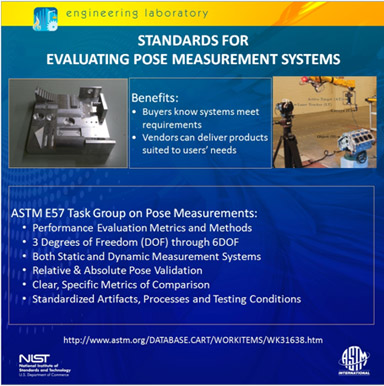| * |
|
Perception in Unstructured Shop Floor Environments
Summary:This project will develop and deploy advances in measurement science and standards for sensor calibration, dynamic object localization and object identification to enable sensing and perception for rapid re-tasking in unstructured environments. Due to limitations in current enabling technology, re-tasking automation on the shop floor must be performed manually. This adds time and expense to re-tasking of critical manufacturing applications, such as welding, painting and assembly, which are performed by industrial robots using rigid fixtures and motions. Improved perception systems would enable more flexible automation and rapid re-tasking. Critical perception capabilities are dynamic object localization and identification and sensor calibration in unstructured environments. The technology for static object localization and recognition has matured significantly, but its robust flexibility for dynamic, agile manufacturing applications has yet to be sufficiently realized for industry adoption. Description:
Objective:
Develop and deploy advances in measurement science and standards for dynamic object localization and identification and sensor calibration to enable sensing and perception for rapid re-tasking in unstructured environments by the end of FY 2014. What is the new technical idea?The new technical idea is to enable sensing and perception for next generation robotics applications in a rapidly evolving environment where inexpensive 3D sensors and open source software greatly lower the barriers to innovation, and to use NIST leadership to develop measurement science to support effective test methods and standards. The steps in the process include: extracting end-user requirements to define performance metrics; developing reliable test methods to measure performance, involving end-users, technology providers, and others in consensus standards-development processes; working closely with stakeholders to refine test methods to ensure buy-in; leveraging, where appropriate, competitions to pilot test methods, evaluate innovative algorithms, and to promote participation in the development of the standards. What is the research plan?The effort will establish partnerships with industry end users during the planning, execution and delivery phases of the project. To support rapid re-tasking of intelligent robots and automation, in FY2012 this project will focus on developing performance evaluation standards for static six degree of freedom (6DOF) localization systems through ASTM committee E57 on 3D imaging systems. This effort will also include standards for performance evaluation of 3D imaging systems. Techniques for calibrating and registering sensors to robots and machines are needed to support sensing and perception system evaluations. In addition, a critical element for the evaluations is the development of methods for obtaining ground truth measurements. These techniques and methods will be developed in FY2012. Ground truth measurement techniques will also be developed to support the other projects in the Next Generation Robotics and Automation program. Efforts for developing Technology Readiness Levels (TRL) for sensing and perception technologies for dynamic localization and identification will also begin in FY2012. These efforts will include industry surveys, workshops, or literature surveys. In FY2013, the efforts will focus on developing a draft standard for the dynamic performance of sensing and perception systems for 6DOF localization and on developing a draft TRL document for these systems. The TRL document will be developed in conjunction with industry partners such as GM, Ford, Chrysler, Army Research Laboratory, USPS, Southwest Research Institute, and Boeing. In FY2014, the focus of the project will be on: 1) finalizing the standard for the dynamic performance of sensing and perception systems for 6DOF localization; 2) developing a draft standard for the object identification performance of these systems or standalone algorithms and 3) finalizing the TRL document. Major Accomplishments:Recent Results: Outcomes
Standards and Codes:
|
 Pose measurement is important to manufacturers who want to be able to manipulate components without having to develop specialized fixtures or other expensive methods of maintaining knowledge of part positions. Start Date:October 1, 2011Lead Organizational Unit:elStaff:Related Programs and Projects:Contact
General Information: Tsai Hong, Co-project Leader Gerry Cheok, Co-project Leader 301 975 6074 Telephone |
